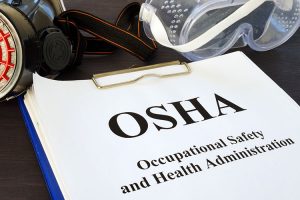In February, OSHA announced a revised National Emphasis Program (NEP) for respirable crystalline silica (RCS) in general industry, maritime, and construction.
In general, NEP’s are designed to focus OSHA’s resources on particular hazards and high-hazard industries. Specifically for RCS, this new NEP targets specific industries expected to have the highest exposures to RCS. And, it focuses on enforcement of the silica standards.
This instruction follows the cancellation of the 2008 Crystalline Silica NEP in October 2017.
The following list highlights the differences between this replacement NEP and the former NEP:
- This replacement NEP addresses enforcement of OSHA’s standards for RCS, promulgated in 2016. One standard covers general industry and maritime, and the other covers construction. Both standards set a permissible exposure limit (PEL) for RCS of 50 micrograms per cubic meter (µg/m3) as an 8-hour time-weighted average (TWA). The former TWA PELs for respirable quartz silica were calculated based on silica content and were approximately equivalent to 100 µg/m3 for general industry and 250 µg/m3 for construction and shipyards (81 FR at 16294, March 25, 2016).
- This NEP contains an updated list of target industries, listed by North American Industry Classification System (NAICS) codes.
- For inspection procedures, this NEP refers compliance safety and health officers (CSHOs) to current enforcement guidance for the respirable crystalline silica standards.
- State Plan participation in this NEP has been made mandatory.
- Area and regional offices shall comply with this NEP, but they are not required to develop and implement corresponding Local Emphasis Programs (LEPs) or Regional Emphasis Programs (REPs).
- Area offices will conduct outreach programs three months prior to initiating NEP-related RCS inspections.
- Area Offices are no longer required to send abatement verification to the national office.
OSHA says this is needed because “occupational exposures to silica continue to pose a significant risk to a large population of workers, and because OSHA’s sampling data continue to show a high rate of noncompliance (i.e., employee overexposures).”
National Emphasis Program Target Industries & Goals
As previously mentioned, the industries being targeted for silica-related inspection include general industry, maritime, and construction.
Related: The OSHA Silica Standard is About to Get More Strict
A complete list of facilities being targeted by 2017 NAICS code can be found in the Appendices listed in the OSHA Instruction Document, National Emphasis Program – Respirable Crystalline Silica, Directive Number: CPL 03-00-023.
A combination of inspection targeting, outreach to employers, and compliance assistance will be used to measure the effectiveness of the NEP’s goals.
Inspection Targeting
- At least 2% of yearly inspections in each region will target RCS workplaces expected to perform tasks associated with RCS overexposures.
- Silica-related inspections will be conducted at a range of facilities that represent a sampling of targeted industry worksites in a region.
- Construction facilities are likely to be the majority of the worksites inspected.
Additionally, OSHA will use an automated process to compile, randomize, and identify inspection targets.
This process is outlined in an OSHA Enforcement Memorandum titled “Establishment-Targeting Lists for Emphasis Programs.”
Outreach to Employers
OSHA has another enforcement memorandum called “Procedures for Local and Regional Emphasis Programs.”
This memo outlines specific techniques and detailed guidance for conducting local and regional outreach programs. The new NEP for RCS requires that at least three months before initiating inspections “each Area Office shall conduct outreach programs… in accordance with OSHA Memorandum on Procedures for Local and Regional Emphasis Programs.”
Related: How to Protect Your Team From the Effects of Silica
All employers, especially those being targeted in the new NEP, which again includes general industry, maritime, and construction, should be on the lookout for these increased outreach efforts.
Employers may want to take advantage of some of OSHA’s compliance assistance offers, knowing that they may be the target of an upcoming OSHA inspection.
Compliance Assistance
OSHA has a variety of resources they will rely on for compliance assistance during their outreach efforts.
It specifically mentions this public webpage in the NEP Instructions: OSHA Crystalline Silica Safety and Health Topics Page.
***
About Worksite Medical
In most cases, OSHA requires medical surveillance testing, and at no cost to employees.
Worksite Medical makes that program easier with mobile medical testing.
We conduct on-site respirator fit tests, as well as pulmonary function test and heavy metal lab work, and OSHA silica physicals right on your job site. We also keep accurate, easy-to-access medical records for your convenience. You’ll keep your employees at work, and stay ahead of OSHA inspections.
With Worksite Medical, a mobile medical testing unit — we can bring all the resources of a lab to you. Our certified lab technicians can perform both qualitative and quantitative respirator tests to ensure a perfect fit.
Protect your team and your workplace now with Worksite Medical. Not sure what you need? Try our medical testing wizard here.
Give us a call at 1-844-622-8633, or complete the form below to schedule an on-site visit or to get your free quote!




